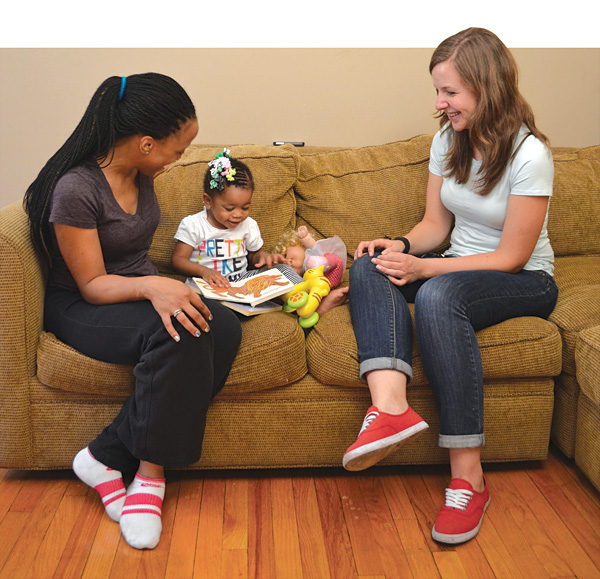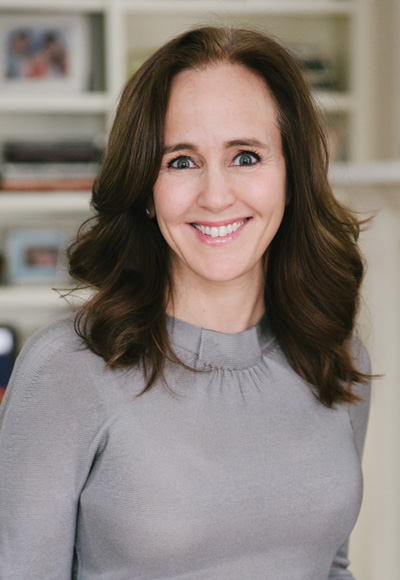Closing the 30 Million-Word Gap

Home visits are an important part of Thirty Million Words’ outreach.
Photos courtesy of Thirty Million Words.
A pediatric surgeon has become an emerging leader in the science of language development and a partner with the Chicago Public Library in a venture to create new interactive learning spaces.
“My journey began seven years ago,” says Dana Suskind, professor of surgery and pediatrics at the University of Chicago School of Medicine. After Suskind had restored hearing to deaf children with an artificial cochlea, “I noticed that some [kids] would be talking on par with their hearing peers, while others would hardly be able to communicate.”
Specifically, children from affluent families were speaking more after the procedure than children from lower-income ones. “I started noticing these differences,” says Suskind, who directs the Cochlear Implant Program at the medical school. “What I was seeing in my hearing-loss population mirrored what was happening in the broader population, with devastating results. We’re talking about the achievement gap.”
To address this problem, Suskind founded the Thirty Million Words Initiative (TMW) in 2009. The program is named after a 1995 study by child psychologists Betty Hart and Todd R. Risley, which showed that at-risk children in Kansas City had heard 30 million fewer words by age three than other kids—and that this deficit had a profound impact on later achievement.
Suskind’s forthcoming book, Thirty Million Words: How to Build a Child’s Brain (Dutton, Sept. 2015), describes her experience and brings her ideas to a mainstream audience. “The bottom line is, what makes a child with hearing loss successful is what makes a typically developing child successful,” says Suskind, who is an advisor to Hillary Clinton’s Too Small to Fail initiative. “Language exposure is what feeds early brain development.”

Dana Suskind
Suskind is also working with the Chicago Public Library (CPL) and the Chicago Children’s Museum to create enriched learning environments, starting with two CPL locations, says Andrea Sáenz, first deputy commissioner at CPL.
Suskind maintains that children are not born smart, but parents help make them so through verbal interaction. She boils down the TMW directive to what she calls the “Three Ts”: Tune In, Talk More, and Take Turns. Another TMW mantra for parents: Don’t just do it, talk them through it. In other words, the quality of interaction between adults and children matters.
This is the kind of advice that parents have received from Suskind’s outreach in Chicago, supported by a mix of public and private funding, including PNC Bank. Targeting socioeconomically disadvantaged families, Suskind says, she is mindful of “balancing the needs of children vs. parents who have scarcity.”
One intervention had children wear a LENA, essentially a word pedometer that counts the words kids hear while wearing the device. Families who used the LENA, had in-home visits, and were given a multimedia curriculum showed a significant increase in their knowledge of language development.
Suskind reaches parents in the maternity ward with TMW’s Newborn Public Health Initiative. While newborn babies get their hearing tested, new parents watch a short video about infant brain development, the importance of language, and what parents can do to enhance that development. Suskind plans to add similar interventions during well-baby visits up to the age of six months. In addition, a longer-term study with the city of Chicago will track 200 children from Head Start families through kindergarten and include weekly home visits.
There’s also a “burgeoning partnership” with national literacy organization Reach Out and Read, in which pediatricians hand out books to children ages six months to five years old during well visits. Suskind notes that joining forces would expand interventions to an earlier age group, with parent education beginning when children are newborns.
Enriching vocabulary in libraries
At the new CPL spaces, “We’re planning to take lessons from Dana’s research and curriculum designed by her team,” says Sáenz. Working with children’s museum designers, CPL will create two initial “demonstration sites” showing how to “use public spaces to support vocabulary development in a very young child.”
With a target launch of early 2016, the library spaces could be replicated around the city—in daycare centers, schools, churches. Suskind envisions public service-type information in bus shelters and other public areas in Chicago to encourage interaction anywhere.
While the American Library Association’s five Every Child Ready to Read practices—sing, talk, read, write, and play—tell parents what you need to do, says Sáenz, “The three Ts start to tease out how.”
The children’s museum’s education and design team have conducted training sessions for librarians “around the notion of play for learning,” she adds. “We have been exploring the best way to make children’s spaces more inviting to play,” and “we’ve found in spaces that we’ve slowly converted that families stay longer and caregivers have the opportunity to interact with each other and librarians.”
Suskind believes that language enrichment is “not just an issue” for families of “low-income backgrounds in this dawning age of technology.”
“I’m very concerned about how much talk and interaction we have with our children,” she says. “Technology isn’t going away, but we have to figure out how to make it our friend. The baby’s brain is still developed by talk.”
RELATED
The job outlook in 2030: Librarians will be in demand
The job outlook in 2030: Librarians will be in demand
ALREADY A SUBSCRIBER? LOG IN
We are currently offering this content for free. Sign up now to activate your personal profile, where you can save articles for future viewing






Add Comment :-
Comment Policy:
Comment should not be empty !!!
Bonnie
I hold a Master's Degree in Elementary Elementary Education. I have always been an advocate for talking with children and sharing new experiences as each new experience offers new vocabulary. I am very aware from my experience in our Title I schools that there is a wide gap between these students and their middle and upper class peers. This is not an issue that can be solved through intervention with the parents as the parents are not in the home or they don't care. I am interested in how do we get to the babies before they enter Pre-k. I am from the State of Alabama. We have many poor and disadvantaged children. Is this program available in other areas besides Chicago?Posted : Dec 30, 2015 07:35